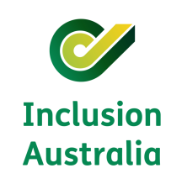What is Individualised placement and support (IPS)
Individualised Placement and Support (IPS) is a variant of the model of supported employment that has evolved since the 1980’s. Unlike Customised Employment, it has a focus on rapid movement into employment, coupled with support to address personal barriers and the ongoing provision of support in the workplace (Lawlor and Perkins, 2009). IPS has been primarily and extensively used with people with serious mental illness e.g., schizophrenia spectrum disorder, bipolar, depression, and has assisted ‘people living with behavioral health conditions work at regular jobs of their choosing’ (IPS Employment Centre, https://ipsworks.org/index.php/what-is-ips/).
IPS is an evidence-based model of supported employment for people with serious mental illness (Becker et al. 2011; Mar-shall et al. 2014). The core principles of IPS include rapid job search, integration of mental health and employment services, attention to client preferences, and individualized job searches and supports … IPS helps clients to obtain and maintain competitive jobs of their choice without long periods of assessment, training, or internships (McLaren et al. 2017, p.366).
IPS has also been used successfully with a range of other groups including a small number of examples with people with intellectual disability (Bond, 2020).
IPS has a strong evidence base that has established the key ingredients needed to make it effective. These have been identified as the 8 Principles of IPS (IPS Employment Center, https://ipsworks.org/index.php/what-is-ips/):
IPS is based on the following elements:
| Name | Description |
| 1. Competitive employment | Jobs anyone can apply for, pay at least minimum wage/same pay as coworkers with similar duties, and have no artificial time limits imposed by the social service agency. |
| 2. Systematic job development | Employment specialists systematically visit employers, who are selected based on the job seeker’s preferences, to learn about their business needs and hiring preferences. |
| 3. Rapid job search | IPS programs use a rapid job search approach to help job seekers obtain jobs rather than assessments, training, & counseling. The first face to face contact with the employer occurs within 30 days. |
| 4. Integrated services | IPS programs are integrated with mental health treatment teams. |
| 5. Benefits planning | Employment specialists help people obtain personalized, understandable, and accurate information about their … government entitlements. |
| 6. Zero Exclusion | People are not excluded on the basis of readiness, diagnoses, symptoms, substance use history, psychiatric hospitalizations, homelessness, level of disability, or legal system involvement. |
| 7. Time un-limited supports | Job supports are individualized and continue for as long as each worker wants and needs the support. Employment Specialists have face to face contact at least monthly. |
| 8. Worker preferences | IPS program services are based on each job seeker’s preferences and choices rather than the employment specialist’s and supervisor’s judgments. |
These principles have been tested and found to contribute to the overall effectiveness of IPS in supporting people to gain and maintain open employment (Lawlor & Perkins, 2009). For example, there is evidence to show that when ‘worker preferences’ are used to match the worker to the job, that increased employment outcomes and job retention occurs (Lawlor & Perkins, 2009). Interestingly, the element of ‘rapid job search’ has been shown to increase employment outcomes, when compared to an alternate strategy of pre-vocational training as a pathway to employment (for people with mental illness) (Lawlor & Perkins, 2009). Further, there is evidence that the provision of ‘time un-limited support’ is also linked to outcomes (Lawlor & Perkins, 2009).
Outcomes
The Individual Placement and Support (IPS) model has a strong evidence base for people with mental illness, achieving high quality outcomes (Becker et al., 2012; Bond et al., 2008; Smith, Atmatzidis, Capogreco, Lloyd-Randolfi, & Seman, 2017). Twenty-seven randomized control trials have been conducted on IPS between 1996 and 2019, spanning multiple countries (most in the US and 3 in Australia) and over 6,000 people with mental illness, which show significant increased employment outcomes for IPS for this cohort over other interventions (Bond, 2020; Drake et al., 2019).
Outcomes have been evidenced in many studies and include:
- Increased earnings
- Increased job satisfaction
- More rapid employment placement (Bond, et al., 2012).
However, IPS has not been used extensively with people with intellectual disability, and there are few studies that attest to its outcomes for this cohort. In a study of 280 young people (16-24 years) with intellectual disability (55% of sample) or psychiatric disability in the US using IPS, researchers reported an average employment rate of 36% as a result of IPS (Noel et al. 2017). In a study of people with Autism Spectrum Disorder, the five participants experienced:
- Increased employment
- Increased earnings
- Increased hygiene
- Increased self-esteem
- Increased social and family relationships
- Increased self-confidence and independence (McLaren et al. 2017).
Key ingredients of success
The principles of IPS have been evidenced to be related to the outcomes of the program and a Fidelity model is available to guide practice, based on the 8 principles outlined above.
In addition, in one study involving a large number of young people with intellectual disability, recommendations were made to help overcome barriers to the success of IPS with this group. These include:
- ‘provide job coaching/training at the work site to overcome cognitive problems’
- ‘provide concurrent social skills training while preserving the IPS rapid job search’
- increasing outreach to the youth and the youth’s family to prevent disengagement from IPS (including in relation to low expectations of families related to young people with disability, and family’s concerns for the young person’s safety) (Noel et al. 2017, p.357).
The IPS model relies on successfully identifying and providing support to overcome barriers to employment. The above study also found that 36% of young people with intellectual disability continued to experience problems with transportation after they found employment which also affected the success of IPS (Noel et al. 2017).
References
Becker, A., Flack, L., & Wickham, C. (2012). Programs That Support Employment for People With Severe Mental Illness: A Literature Review International Journal of Psychosocial Rehabilitation., 16(1), 52-58.
Bond, G. R., Drake, R. E., & Becker, D. R. (2008). An update on randomized controlled trials of evidence-based supported employment. Psychiatric Rehabilitation Journal, 31, 280-290.
Bond, G.; Drake, R. & Becker, D. (2012). Generalizability of the Individual Placement and Support (IPS) model of supported employment outside the US, World Psychiatry, 11(1): 32–39.
Bond, G. (2020) Evidence for the Effectiveness of Individual Placement and Support Model of Supported Employment, powerpoint, https://ipsworks.org/index.php/evidence-for-ips/
Drake, R.; Becker, D.& Bond, G. (2019) Introducing Individual Placement and Support (IPS) supported employment in Japan, Psychiatry and Clinical Neurosciences 73: 47–49
IPS Employment Center, https://ipsworks.org/index.php/what-is-ips/
Lawlor, J. & Perkins, D. (2009). Integrated support to overcome severe employment barriers. Adapting the IPS approach, Social Policy Working Paper, No. 9. Melbourne, Centre for Public Policy, University of Melbourne and Brotherhood of St Laurence, http://library.bsl.org.au/jspui/bitstream/1/1367/1/Lawlor&Perkins_Integrated_support_employment_barriers.pdf
McLaren, J.; Lichtenstein, J.; Lynch, D.; Becker, D. & Drake, R. (2017). Individual Placement and Support for People with Autism Spectrum Disorders: A Pilot Program, Adm Policy Ment Health, 44:365–373.
Noel, V.; Oulvey, E.; Drake, R. & Bond, G. (2017). Barriers to Employment for Transition-age Youth with Developmental and Psychiatric Disabilities, Adm Policy Ment Health, 44:354–358
Smith, D., Atmatzidis, K., Capogreco, M., Lloyd-Randolfi, D., & Seman, V. (2017). Evidence-Based Interventions for Increasing Work Participation for Persons With Various Disabilities. OTJR: Occupation, Participation & Health, 37, 3S-13S.
The authors would like to acknowledge the usefulness of Crosbie, J.: Murfitt, K.; Hayward, S. & Wilson, E. (2019), NDIS Participant Employment Taskforce. Literature review: Employment and economic participation of people with disability, Burwood, Deakin University, as a review of similar literature that provided initial guidance.


